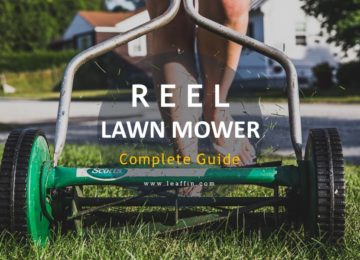Synthetic fertilizers and pesticides can be more harmful to our environment than beneficial to lawns. These chemicals kill beneficial microorganisms in the soil. And all fast-acting fertilizers are far more likely to run off and pollute our waterways than slow-release fertilizers that stay in the soil and are gradually released to the plants. Of course, we agree with the standard recommendation that instructions be followed and that soil be tested to determine if fertilization is needed.
Turfgrasses can receive all the fertilizer they need from a combination of: using a mulching mower to leave grass clippings on the lawn, adding clover, and applying a layer of compost. Also, any of those can be used in combination with a slow-acting, organic fertilizer product, like alfalfa meal.
A slow-acting organic fertilizer product can be applied once a year to lawns. In most climates and for most turf grass species, fall is the best season, but warm season species (zoysia, Bermuda, St. Augustine, centipede grass and others) should be fertilized in mid to late spring/early summer. A second feeding? Only if there’s a particular need; e.g., to restore a neglected lawn.
Pesticides
We’re concerned about environmental harm caused by pesticides, as well as toxicity for humans and pets, and recommend using regionally appropriate Integrated Pest Management. Resources we recommend about pesticides are here, and if you know of others, please send us the link.
Weeds and Weedkillers
The best way to keep weeds down in a lawn is to have a thick, healthy lawn by overseeding in the fall, and by fertilizing as outlined above.
For preventing broadleaf weeds we recommend applying corn gluten in late winter when the forsythias bloom. In the recommended dose, it also provides significant nitrogen.
We recommend against synthetic weedkillers for the lawn, especially the ones in the common weed-and-feed products.
And two plants considered weeds for decades are making a comeback – and for good reason. Clover is a nitrogen-fixing natural fertilizer and great for the pollinators. Dandelions are lovely in bloom and edible, too. They’re excellent ingredients in a “freedom lawn”, the new term for a laissez-faire mix of turfgrass and weeds.
Water
We disagree with the old, water-wasting advice to give lawns an inch of water every week. Rather, lawns should be allowed to go dormant in the summer and in the winter. Healthy turfgrass grown naturally is pretty, though in a different way than the drug-addicted green perfection we’re told to emulate.
We recommend more drought-tolerant species of turfgrass, where possible. They include Buffalograss, mixes of fine fescues, Bahia grass in parts of Florida, sedges in wooded areas, and so on – whatever is best for your region. (More info.)
We think that if your climate does not provide enough rain to sustain a lawn, it’s best to find something else to plant. But if you do irrigate, use an efficient system. Install a smart controller that automatically adjusts irrigation schedules based on environmental factors and replace traditional spray heads with matched precipitation, low application rate heads. Too much water is wasted with “set-it & forget it” systems that water whether it’s needed or not.
Mowing, Blowing and Discarding
Lawns should be mowed at the highest recommended height for the dominant species of grass. In most cases it will be at least 3 or 4 inches.
Gas-powered mowers and blowers are the worst offenders in the categories of air pollution, noise pollution and obviously, the use of fossil fuels. Electric mowers are far better, and push mowers are the ideal (where possible).
Less Lawn
Here’s where we put in a plug for reducing or eliminating turfgrasses when they’re not needed for their toughness. “Lawns” could be composed of more sustainable groundcovers, or converted to something totally different – ornamental grasses, flowering perennials, shrubs, trees, pervious patios, edibles, even a meadow.


